|
FAQs about Dendrophylliid Coral
Reproduction/Propagation
Related Articles: Dendrophylliid Corals,
Related FAQs: Dendrophylliids 1, Dendrophylliids 2, Dendrophylliid Identification, Dendrophylliid Behavior, Dendrophylliid Compatibility, Dendrophylliid Selection, Dendrophylliid Systems, Dendrophylliid Feeding, Dendrophylliid Disease, Stony/True Coral, Coral System Set-Up, Coral System Lighting, Stony Coral Identification, Stony Coral Selection, Coral Placement, Foods/Feeding/Nutrition, Disease/Health, Propagation, Growing Reef Corals, Stony Coral Behavior,
|
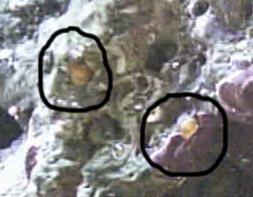
|
|
Strange things on Tubastreas
6/20/13
Hi Folks!
Here's hoping you got the three photo attachments with this e-mail so you
can see what's going on here. These Tubastrea colonies are a little
over four years old each and for the last few months these little spaghetti
looking things that are screaming electric yellow appear on a few polyps for
a day or so then disappear, only to reappear a few weeks later. I
haven't noticed yet if the same polyps keep having this happen to them or if
they're different polyps each time. The colonies (all two of them)
appear very plump and healthy. Whatever these things are, they don't
seem to be harming the colonies as they continue to exhibit rather robust
growth with over three dozen polyps in each colony with more on the way.
Both colonies were started with four polyps each, all of which were less
than one millimeter across when we got them after having been starved for
over a year and a half and rescued from certain death. Nowadays, they
are target fed once or twice a week with a really good frozen reef critter
food from my favorite LFS using a small turkey baster. Anyway, could
these yellow spaghetti things be planulae?
<Mmm, yes>
Borneman's book Aquarium Corals, and Calfo's Book of Coral Propagation both
mention planulae but I've never seen pictures of them.
<See here on WWM:
http://www.wetwebmedia.com/dendroreprofaqs.htm
These colonies have to be releasing planulae because baby Tubastreas keep
popping up all over my tank, almost always on the very mature pieces of live
rock totally covered with pink coralline algae. Judging from the
different sizes of the baby polyps, there have been three separate waves of
planulation that have successfully dodged the tank's filtration system and
settled out. Right now there are three colonies in the tank that have
started from planulae and have three polyps each after about a year. (
I feel like a grandparent now) I checked out the articles and
photos of Tubastrea reproduction on your site, but couldn't find any actual
photos of a Tubastrea polyp releasing planulae.
<Don't think we have this>
The only other possibility I can think of is that these yellow "worms" are
related to food processing/regurgitation/defecation although they have never
appeared near the mouth but down where the polyp body meets the tissue that
covers the calcite skeleton. So at least for now, all the Tubastreas
appear fat and happy. Thank you for any help you can offer and tell me
if you didn't get the attached photos and I'll try sending them again.
Oh by the way, your site rocks! I've been visiting this place for over
six years now, and recommend it to every fish geek (like me) who doesn't
know about you yet. My seven year old reef tank would never have made
it this far without your help! Thanks again.
Gregg from Golden, Colorado
<At first I thought these might be mesenterial filaments, but now am placing
my money on reproductive event. Bob Fenner>
|
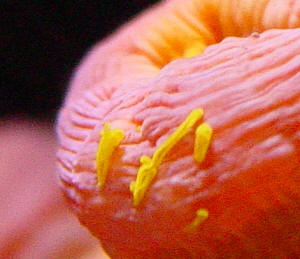
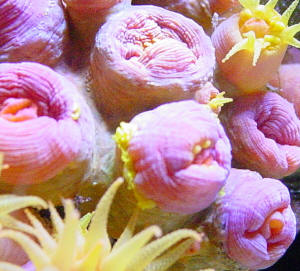
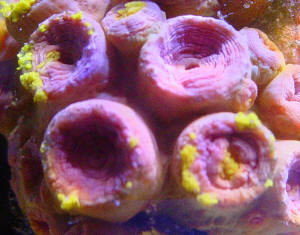 |
Propagate Corals 5/19/12
Dear WWM,
I have a wonderful Duncanopsammia axifuga that I
would like to propagate. I bought it as a two polyp coral; shortly
afterwards it developed small bumps along the base of one of the polyps.
After a few days I noticed that they appeared to have small mouths. I
continued to continue what I had been doing in hopes that I would get a
nice reward. Anyway, now I have one polyp with 6 heads on it. They are
still all attached to each other, and I assume that before fragging I
will need to let them separate?
<Yes>
What tools should I use for this?
<A simple metal clipper or even flat-end screwdriver that can be fitted
twixt the basal hard (carbonate) skeletal joinings... leveraged to snap
off the individual polyps of this Dendrophylliid>
Could a hack saw work for cutting through the skeleton without much
damage?
<Too much chance of damage; and unnecessary>
Also, could they be sold?
<Yes>
If so, what would a reasonable price be?
<Depends on the market thereabouts... see the Net>
I received them online for 15$ per polyp, and don't know if I overpaid
or stole them.
<About right>
Also, I have a small Caulastrea
furcata which seems to be doing well. I fed it some Mysis shrimp last
night, which I try to accomplish with some frequency. Is this
appropriate?
<...? Yes>
I also dose the tank with Kent ZooPlex weekly. I had seen posted that
these corals do not need fed frequently so I assumed that weekly would
be enough.
<Depends... I'd double this frequency>
I also am receiving a package of Galaxea fascicularus, Tubastrea spp,
and Trachyphyllia geoffroyi. I was wondering if you would suspect the
allelopathy to be especially high?
<For the first, yes>
I did a bit of research, and read that
these with the exception of the Galaxea fascicularus tend to be
peaceful.
Would water changes, good flow, plentiful food, and carbon be enough to
"keep everyone from getting cooked?"
<You'll see; likely so>
I keep salinity at 1.025, NO3-: 10ppm, NO2-: 0, NH3: 0 PO4: .10ppm, Ca:
420ppm, Mg1350ppm, pH: 8.1, KH: 10, Temp: 78 degrees under four 65 watt
power compacts. Thanks for your time. Happy day before the weekend!
Bryce
<Keep searching... w/ your curious mind you'll do fine. Bob Fenner>
Reef tank... Free HH Duncans, sawing away. Prop. input
3/25/10
Hello my name is Eric,
<Hello Eric>
I recently purchased a frag mushroom coral and I've noticed that
there are about 9 tiny Duncan corals sprouting underneath the
mushroom.
<Lucky, very very lucky>
Is it safe to cut the Duncan coral to move them somewhere else?
<Yes, if this is what they are. Can you post a photo to confirm?
Duncanopsammia axifuga is a very easy coral to propagate this way.
Either carefully snip or hacksaw the skeleton off at the base (I prefer
a clean hacksaw blade cut) and stick to a rock using some putty. Keep a
reasonable
distance between each head, as this coral will grow quickly, especially
if you target feed it>
And if so where is the best place to cut them at?
<Posted>
What would be the best procedure to attach them to another rock.
<Two-part epoxy putty. I like Milliput, the terracotta one>
What other materials can I attach them to?
<Just use a rock>
Thanks for your time
<No problem, Simon>
Fraggin a Duncan Coral 12/2/09
Hello, first thanks for all the help getting my 150gal reef to where
its at today, couldn't have done it without you.
<Some fun now!>
I have a Duncan Coral with about 12 heads now and its getting too big
for the little stalk it is growing on. I want to frag it for the
purpose of selling some of it and also spreading it around my tank a
bit. I have read somewhere that you just break off the stalks? Does
that sound right to you?
<Mmm, yes>
If not, could you give some basic info on the process?
Thank You,
Gary
<Sure... after making sure of the health of the colony, securing a
plastic tray and hand tools... Pick up and gently "shake" the
specimen in the main/display tank to have it pull in its polyps and
tentacles, lift it out into the tray, and choose your surgical tool...
If the specimen is small enough, a large flat-head screwdriver may
serve. Insert this twixt the area between "heads" you'd
like to separate and with your other hand on the opposite side (for
support) of the colony (between heads as well), twist the screwdriver
laterally, and you will very likely find that this will bring about a
fracture of the pieces. I would rinse all, do a concentrated iodide-ate
bath-soak for a few minutes, and replace the pieces in the system
whence they came. Bob Fenner>
Double dendro 9/27/07 Wet web media,
<Joe> Hey guys, how are you. <? Okay> The crew has most
likely seen just about everything so I thought I might ask if you
have seen this before. I have an orange dendro colony that started
with seven heads. After feeding it daily for about 6 months it
reproduced babies. One of the polyps has two heads that shares the
same skeleton. <Neat! And yes, have seen> All the arms are
independent except one that is in the middle and is split at the
end. Is it one animal or two separate. <In process...> I ask
because if I accidentally feed one more than the other, will one
grow larger. <Try it and see> It reminds me of the cell
division and a 2 headed snake in my biology book growing up. Thank
you for your time. -Joe
<Thank you for writing, sharing. Bob Fenner> |
|
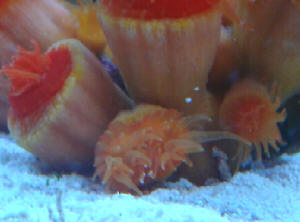 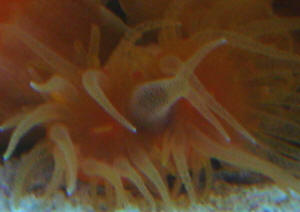
|
| Sun corals everywhere! 2/16/07 Houston we
have a problem... Hi Bob... I really tried to have a heart to heart
with my animals. <Heeee! Good luck, esp. with cats!> I told
them that under no circumstances are they to make me a grandma.
Their new home is not really the ocean but a 10 gallon tank. It
didn't work! Not only have my tree corals been spawning the
last couple days but I have just discovered that my sun corals beat
them to the punch. Some time in the past two weeks they did the
same. I had noticed the past week these tiny orangish spots on the
rocks and thought they were the start of Sycon sponges of which I
have several. This morning I noticed a spot on my Astrea snail and
pulled out the old magnifying glass to have a closer look thinking
a Sycon sponge was forming on it Alas, a baby sun coral with polyps
extended. Uh-oooh. Upon further inspection I have now counted 15
small orange spots around the tank - that I can see - but mostly on
this one large rock. Can we say species tank? <We can>
There's no way I can feed them without possibly causing water
quality issues. <Mmm... perhaps this is my cue to launch into
your "new tank" program... or a sump/refugium?> The
majority of them are still in formation as now using a magnifying
glass I can see numerous flat orange spots on other rocks... new
count 25. I'm sure there are tons more. I've only had these
guys in my tank 3 weeks. Maybe I shouldn't add a second shrimp.
My luck I'll have a pair and baby shrimp everywhere. Do Green
Star Polyps spawn as well? <Yes... all on sorts of
"timed" schedules... having much to do with moon/tides,
temp.s... and other life/reproductive cycles of other species... a
magical myriad solar dance> If so, do they hide before spawning?
<Usually so, yes> Please say no. Or could all this birthing
activity and unseen chemical release in this tank have caused them
to hide? <That too> On another note, the purple coralline I
have here is fading, I don't think it likes the lighting. I had
read somewhere that when the edges turn white it is growing.
<Mmm... maybe...> Is that true? <Could just as well be
receding...> A native Floridian, avid diver for over 20 years,
underwater photography for 7 years, instructor for 2 years before
having to move to Dallas, TX, and I can't believe how much I
don't know about the underwater world I so love. Have a great
day, Debra P. <Thank you my friend... Excelsior! BobF> |
|

|
Sun coral babies update... 5/29/07 Hi...
<Hi Debbie, Mich here.> Just thought you might like to add
this picture of my 2-1/2 month old baby sun corals as a reference.
Their tubes are just starting to become noticeable and slightly
rising above the rock's surface. The parent colony is in the
background. <Thank you for sharing.> The glutton for
punishment that I am, I purchased a colony of yellow sun corals (I
could not find their scientific name). <Tubastrea aurea>
Unfortunately, they are not in great shape. One polyp is slowly
dying. The day before it's skin coat looked like it had
blistering and then yesterday morning I noticed an unusual amount
of dark slime surrounding it. I gently blew it away with a turkey
baster only to reveal a white skeleton. Its center is intact and it
appeared to eat last night. I am feeding them every night adding a
couple drops of Selcon to their container water and soaking their
food, too. Poor handling during shipping and poor feeding has taken
its toll on them. Hopefully with TLC most of them will become
stronger and their skin coat will spread and fill in those bare
areas. <Good luck!> Thanks.
<Thanks for sharing! Mich>
Regards, Debbie |
|
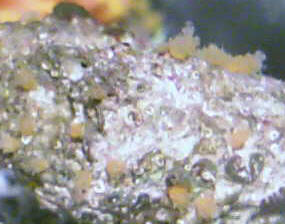
|
|
Baby Tubastrea 3/07 to 8/07 - 08/05/07 Hi
all, <Hi Debbie, Mich here.> Thought I'd update you on
my baby Tubastrea. <Excellent!> Others may be interested.
<Yes, most definitely!> I have 4 additional colonies
besides these babies. The parent colony of these babies, a yellow
Tubastrea, the black diaphana and another orange Tubastrea. All
kept in a 20-gallon tank but fed in a separate 3 gallon tank
every other day. <An interesting and apparently a successful
technique. You remove each colony and place in a 3-gallon tank in
order to feed the colony? Is this correct? What are you feeding
the colonies with? Do you use Selcon? Do you feed all the
colonies at the same time or individually? How long do you allow
them to feed? Do you keep this tank set up all the time or do you
just add enough water to allow for feeding? Is there any
circulation/filtration/live rock in this tank generally? Is there
any circulation during feeding? How are you water parameters in
this tank? How often do you change the water in this tank? Is
this tank lit? I'm sure there are other question should be
asking. I'm curious and I'm sure others would be
intrigued as well in any details you care to share.>
Thanks,
<No, thank you for sharing! Mich>
Debbie
|
|
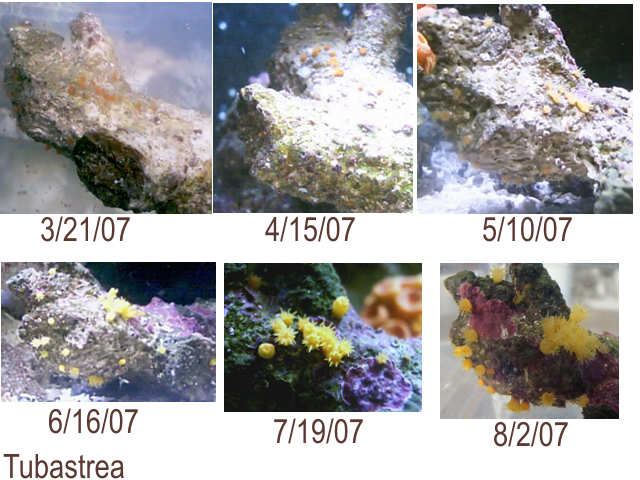
|
Re: Feeding of Tubastrea.. Follow up to Baby Tubastrea Timeline
8/7/07 Hi all... <Hello again Debbie.> Mich this is a follow
up to your questions, hope this is helpful. <Oh most definitely!>
Because my sun corals are housed in a 20g tank feeding them in the tank
would most certainly cause major quality issues. <Assuredly.> So
every other day I completely set up a 3 1/2 gallon plastic critter
tank. It is filled between 1/2 to 3/4 with fresh saltwater, a heater is
added and a 5-10 internal filter. I let everything run until the water
temp matches the temp in the tank. I check the pH. The lights have been
off in the main tank a while so it has started to drop. If there's
a significant difference I mix a bit of buffer in RO and add to the
3-gallon tank to bring it up a bit. I have two containers (Tupperware
type) that have been cut to accommodate moving the corals. One small
one for the smaller colonies and one large one for the large colony of
mixed black and orange. They are never exposed to air during the
process. <Good technique.> The water from their moving containers
fills the rest of the 3-gallon tank and becomes part of my water change
for the main tank. After they are placed inside I put the Whisper
filter back in (it was removed to make room for moving the corals in)
and turn it on without any filter media. I have cut the flaps on the
impeller to slow down the movement as it is purely for circulating food
in the water. I start with Sweetwater zooplankton to whet their
appetite, but I have found that they apparently recognize my scent
because anytime I place my hands in the tank they begin to open in
anticipation of moving to feed. <Interesting Pavlovian response.>
Anyway, I circulate zooplankton and maybe brine shrimp. In the mean
time mini mysis are being thawed in another container. I do add Selcon
but not every feeding. <Very good.> Taking the recipe for food
from "The Conscientious Marine Aquarist" <Fenner's
Wonderful Marine Mash, is of course one of our favorites!> I also
vary their diet with a mix of seafood (snapper, grouper or dolphin,
<dolphin???><<Likely Coryphaena hippurus... Dorado, Mahi...
RMF>> oysters or mussels, shrimp then some frozen Formula One
added blended and then frozen in egg crate to make cubes) The cubes are
grated to make small pieces. I let the corals feed on floating food for
a while and then turn off the filter. Using a homemade syringe made
from rigid 1/4" tubing that I bent at the end and an ear syringe
which I cut the end to accommodate the tubing, I draw the mysis shrimp
into the tube and then start feeding each polyp. By the time I get to
the last colony the first colony fed is ready for more. I try not to
feed more food than appears to fill the polyp cavity as I find that
even though they keep eating they will regurgitate. So giving them just
enough food to fill their "tummy" keeps them from
regurgitating. <Very good instinct on your behalf.> One colony
(the orange in the top left of the picture) uses a slime coat to
capture their food and are the slowest eaters. (This is my original
colony purchased the beginning of the year and the parent colony to the
babies.) The whole feeding process (not including setup) can take about
3 hours. <Very time consuming.> But the last hour I pretty much
have just left them to finish eating and then I start the filter again
to recirculate any food on the bottom which they can capture and eat.
To finish I put a piece of filter pad into the filter and begin
siphoning out any food remaining with a baster. I do a bit of a water
change because any phosphates from the food and the food itself will be
transferred to the main tank when I move the corals back. I have two
cleaner shrimp who know exactly what their job is when I put the corals
back in the tank and that's to clean up any excess food
between/around the polyps. <You show tremendous dedication and have
been rewarded with excellent growth and reproduction.> Included is a
picture of the corals in their tank ready to be fed and a picture of
the three corals consisting of four separate colonies. The yellow were
pretty much a rescue as they had not been fed regularly if at all and I
lost 4 polyps before the end of the second day that I had them. One
polyp I almost lost as it lost a portion of its covering its white
skeleton is showing, but it's eating and doing okay now and I'm
hoping that its tissue will come back and cover the rest of the exposed
skeleton. <Has about as good as any in your excellent care!>
Regards, Debbie <Debbie that you for sharing your amazing husbandry
methods. You are quite dedicated. Might I encourage you to pen an
article on your experiences here? I'm sure Bob would assist you in
making contact with potential publishers. Mich> <Yes. Please do
consider putting all together in an article format. I will gladly aid
you in rough editing and introduction to the print and on-line zines.
BobF> Re: Feeding of Tubastrea.. follow up to Baby Tubastrea
Timeline 11/4/07 Robert, <Deb> I apologize for the delay in
responding to this email... both because of my work schedule and
thinking over if I could do something to this end. <No worries>
My sun corals have spawned again and I have a new batch of babies. And
the jury is still out on this one but I think my black sun corals may
have spawned as well. <Oooh, was watching a show re: Raja Ampat last
night and though the spiel was a mix, there was the mention a few times
of corals challenging/modifying species concepts, and the notion of
super-species...> They're tiny but their coloring is very much
like Aiptasia yet their tentacles are very different, and they're
scattered just like the orange sun corals. Anyway, this whole
experience has been fascinating to say the least but especially
informative as well. These colonies appear to take years to develop,
have special feeding requirements and cannot be propagated easily. So
I'm hoping by having this information out to hobbyists it will make
them think twice about purchasing them. Because of this, on a personal
note, I would love to see them stay in the ocean and no longer sold at
LFS's. <!? But how much progress could/would be made in
understanding their biology... and the interest generated... might well
have a multi-order of magnitude influence on humans... I am resistant
to such regulation> Workwise this is season for me and I'm
pretty much loaded 7 days a week, <You lazy bum! Only seven?
Heeeee!> but I think sometime the first of the year would be good
for me to get an article out and give me some time to arrange info in
the meantime . If you find this acceptable, please let me know
guidelines, and possibly links to other articles written on subjects to
get an idea of format, etc. and any other ideas you have for this as
well. Thanks again, Debbie <Crank the piece out as you see fit...
length, format unimportant for now... And I'll help you place it
mach schnell in the print press... and we'll figure out the e-
placement and follow-ups later... and take pix! Cheers, Bob
Fenner>
|
Baby Tubastrea update - 2 years 01/19/09 Hi
all. <Debbie> This is a follow up to the Tubastrea timeline
"Baby Tubastrea 3/07 to 8/07" under
'DendroReproFAQs. <Ahh!> Well the babies are almost 2
years old now. This picture was taken in December, 2008. They are
now joined by both black and yellow Tubastrea babies which have
grown much faster in less time. <Interesting... the black ones
esp...> Bob, I'll look forward to meeting you (if
you're not too mobbed) at our Next Wave 2009 in Dallas this
coming Saturday. <Sounds great! Will be there> Thanks.
Debbie Piedra <Bob Fenner>
|
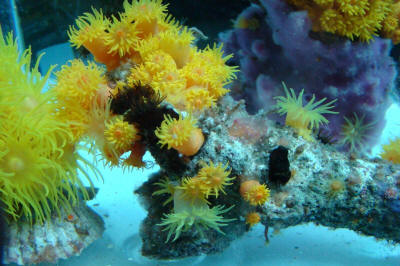 |
Balanophyllia Reproduction 1/19/07 Probably a dumb
question - but if I start out with one single polyp of Balanophyllia,
will it eventually produce baby polyps? <Mmm, this Dendrophylliid
can produce such asexually, yes...> I read they were
"singular" in nature and couldn't find out much about
their reproduction. Thanks, Doug <See/search with the correction of
your spelling above. Bob Fenner>
Katrina the Sun Coral (Of Katrina and The Waves, of course) :o)
6/24/06 Hello, Anthony, Bob, or whom ever I lucky enough to get!
<Ho buoy...> I did look through everything for sun coral info,
but all I could seem to find was feeding/care/space warfare related, so
here goes: I have a sun coral that I got at half price a year ago
because 2/3 of it's little polyps were skeletal. Now, it covers
about all but three heads of it's rock (About 40-50 large polyp
heads), and has 30-40 tiny polyp heads taking over the rest.
<Neat!> ::The Crowd Goes Wild:: I spot feed saturated brine
shrimp and other treats every day, because she is my favorite in the
tank... though I have to admit becoming a bit addicted to zooanthids of
late. <Careful with these> My question is, I have a friend who
has watched this happen, and had always wanted a frag of Katrina. I
would also like to have a frag of her to trade now that she is so big.
Is this safe to do for her, and what is the best way to go about it?
Your friend in Maine Laurie <Can be carefully split twixt the
polyps... corallites that are broken themselves will not likely
"make it". A sharp tool (e.g. a chisel) to split the rock
it's attached to, eye protection... Bob Fenner>
Was that
spawning by sun coral 9/9/03 This is Ameya, I am a regular visitor
to the site wetwebmedia.com and it is fantastic. It gives a whole lot
of ideas regarding various aspects of marine aquarium. This is my first
e- mail to your website. <welcome!> I am new to marine aquariums
but do have a 60 Gallon one set up by my self and a friend of mine who
is a retailer of marine and freshwater aquariums some six months ago.
It has three 2000 L/Hr. capacity power heads, two 900 L/Hr. attached to
UG, and another 900 L/Hr. attached to a homemade skimmer, 10 40Watt
tube lights (no external filter, no sump, no chiller, no calcium
reactor). I maintain sal. 1.021, PH 8.3-8.6, nitrite is nil. <for
successful coral keeping, do allow some small amount (<5ppm) of
nitrate to linger as a food source> I have three spot damsel,
electric blue damsel, yellow damsel, smoke angle each along with them I
do have three carpet anemones, a long tentacle, sun corals, and a
pulsating coral (sub category unknown) it can be ripped off stone and
stick on any thing (it grows on standing glass as well) it has
branches, with white tentacles and it grows sending new runners along
its mother branch. These two types of corals are collected from a near
by sea shore which has very dirty water. <understood... but do be
careful about mixing anemone species together and mixing any anemones
with corals for long-term success. It is usually difficult if not
leading to mortality or disaster from aggression or movement in the
tank by the motile species> One day when I came back home I saw the
sun coral had a swollen look to it and the usually fluttering tentacle
almost invisible after observing for ten to fifteen minutes carefully I
saw white clouds being thrown out of their mouths, I suspect spawning
must have taken place, but I wonder whether it is possible in such a
small aquarium. <yes... it is possible and has been documented. If
the even is asexual planulation, larva will almost certainly settle out
successfully. Do see the reports from Joe Yaiullo (New York aquarium)
on the topic> After approx. three days the tentacles were no where
to be seen I thought the coral was dead, it was almost covered by
diatom algae but after three to four weeks I was shocked to see
tentacles coming out again. For that matter they haven't come out
completely yet, I want my coral to survive, I will be thankful please
give your expert advice, also expect a proper name for the above
mentioned pulsating coral. <Xeniid corals are the only notable group
of corals with pulsatory function. You may have a Xenia. As to the sun
coral activity... they are weekly aggressive and may very well suffer
after some weeks/months to chemical warfare (no touching needed) by the
anemones which do not belong in the same aquarium. Best of luck!
Anthony>
Easy way to get sun coral (Tubastrea) spawning 4/10/04 Hello,
Dr. Bob, <Anthony Calfo in his stead> Five to six months ago I
wrote to you about sun corals spawning in my tank, two months ago there
was power failure for about 2hrs. Or so, and I noticed my sun corals
spawning again, I thought it was just a routine as they do tend to
spawn every month. A week later I was drilling hole into the tank to
connect it to the sump and I turned the filtration off and lowered the
water level then I noticed the sun corals spawning. Then I decided to
go forward with the experiment of turning off filtration and observing
whether the sun coral spawn or not, and after caring out this
experiment three to four times at the interval of 10 to 15 days I
reached the conclusion that when the water movement is absent the sun
corals do tend to spawn. <very interesting!> As I can collect the
sun corals from the near by sea shore only on the days of full moon or
no moon when there is no water movement as the water level drops, I
guess they must be spawning every 15th day. Since I don't have any
other hard coral in my tank, I would be more than happy if you carry
out this experiment and let me know whether this technique works or not
on other hard corals. AMEYA <fascinating information my friend...
thank you so much for sharing. Please do follow up with more when you
can. With kind regards, Anthony>
|
|

